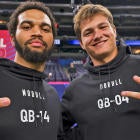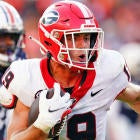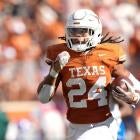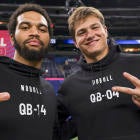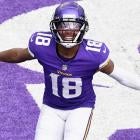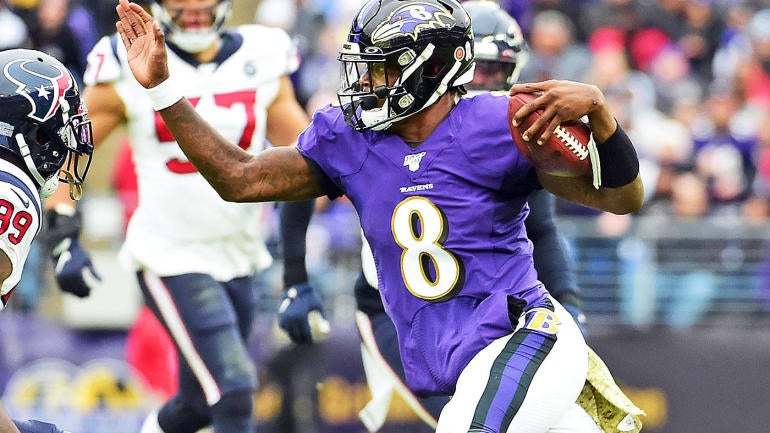
On Fantasy Football Today, we often discuss our draft strategies for various Fantasy league types, and one thing I often think I don't mention enough is how my strategy — not taking too many running backs early, targeting upside, and building a team not for Week 1 but for the entire season — would change for different formats. Not all of you are playing PPR, and you aren't all in leagues that start three wide receivers, either. I've made the case this offseason Fantasy leagues should start far more players than they always have, and that three wide receivers is only just the beginning of needed wide-ranging changes to make this game less dependent on having one or two league-winners. Alas, your league may not care. And you still need to have a plan.
Let's talk about some different league sizes and types and how they influence my strategy. For reference, the strategy I'm discussing often includes a running back in Round 1 or 2 (but not always!), but then several rounds of focusing on wide receivers or perhaps a tight end and ignoring running back, before finishing with many late-round upside bets at the RB position. This may seem wild to pretty much anyone who recognizes the importance of the RB position in Fantasy, but just because running backs are valuable does not mean we are good at identifying which ones will succeed. In fact, Average Draft Positions have historically struggled to identify high-end running back producers from about Round 3 to Round 7, and that's an important piece of the puzzle when considering whether they are the best picks early. I discussed more about the reasons for this strategy in a recent draft review.
Here's how your strategy should change for Non-PPR and .5 PPR leagues, smaller/shallower leagues, and even some of the unique formats that are starting to grow in popularity.
Non-PPR or 0.5 PPR
If you're in a non-PPR league, the calculus immediately changes. First of all, specific player targets adjust. I'm frequently talking about being down on running backs who don't catch a lot of passes, something I expanded on while naming the specific early-round backs who are bust candidates. Those specific backs are far more palatable in non-PPR formats — that article is basically a list of the backs you should raise in your non-PPR ranks — but it's worth noting it still doesn't hurt to have a back who plays in the passing game and is less dependent on game script and high rush attempt totals for points. We still prefer three-down backs in any format; the elite rushers like Derrick Henry are just way more practical in non-PPR.
Similarly, part of being WR-heavy in PPR leagues is the ability to fill the Flex position with a productive pass-catcher, and we should prefer wide receivers in our Flex spots in that format. But in non-PPR, the preference is to fill the Flex position with a running back, assuming you can roster enough good ones who stay healthy. It becomes much more practical to lean into the fragility of the running back position with a RB-RB start, and maybe three through four rounds. I still wouldn't go too far overboard, because the more backs you take, the more you are compounding your bust risk. And you still have the potential to build out a strong backup RB corps in the later rounds with guys who could see significant spikes in value later on.
In a league that awards 0.5 PPR, things are a little less clear, but especially this year, I still tend to prioritize a RB in my Flex spots more than I otherwise would in PPR. In a recent 0.5 PPR Salary Cap Draft with the CBS Fantasy that we're playing out where we start two running backs, two wide receivers, and have two Flex positions, I leaned heavily into trying to build out a deep running back group with upside. I drafted just four wide receivers, and didn't go up to the elite tiers for any of them. Chris Towers compared his roster and mine in yesterday's newsletter, which I highly recommend signing up for.
One more big change for me as things move from PPR to non-PPR is to prioritize wide receivers with high average depths of target. Downfield threats tend to catch fewer passes and do more with them, so when there is no value placed on the reception but only on the yards and touchdowns, those are the wide receivers to chase.
Smaller leagues
In 10-team leagues or leagues with shallow benches — think five or fewer bench slots — draft strategy also changes, even in PPR. You may have noticed bye weeks are stacked up aggressively this year, as a built-in contingency to help facilitate the rescheduling of games if necessary. In shallower leagues where managers may have to grab two or more bye week fill-ins at once, you'll often see legitimately talented players dropped.
Typically, the position most widely available in these formats is going to be wide receiver. Last year, in a podcast listener league and a couple of other internal shallower formats, I added Courtland Sutton, Tyler Boyd, and Jarvis Landry off waivers at various times across multiple teams. In high stakes drafts I participated in last offseason, each of those players was a single-digit round pick in drafts that go at least 18 rounds, and you would almost never see them hit the wire, even if they were hurt or seriously underperforming.
This dichotomy is especially true when the league only starts two wide receivers. Those two considerations — league size and depth of the starting wide receiver slots — are both additional factors that have a similar effect as discussed above, in that they will drive me toward a more running back-heavy build in the early rounds of drafts.
But in this case, it also means I'm more likely to prioritize an elite tight end. This is a little counterintuitive, because tight end is not typically a deep position, so in shallower formats the replacement level on waivers should be noticeably higher. But the replacement level at other positions — particularly wide receiver — rises even more, and comparatively wide receiver in the early rounds becomes less of a priority than tight end in the early rounds. With fewer demands on my top picks, I'm more likely to use what many might consider a luxury pick to lock in a stud at tight end.
The advantage an elite tight end can provide you still remains reasonably large, and there's also a built-in advantage of not using a second roster spot on a backup tight end if you have one of the true elite options.
Unique formats
There are so many different kinds of leagues to consider, from SuperFlex to TE Premium to point-per-carry or point-per-first-down scoring formats, and many more.
In very deep leagues or TE Premium formats, I also tend to prioritize elite tight ends, because I don't want to spend several mid-round picks trying to build a reasonable committee at a position that can dry up quickly. In SuperFlex, I'll obviously move quarterbacks up, and if it is a 2QB league where that second spot can't be flexed to another position, I'm striving to grab three guys I think will start 16 games. There's always a game of chicken in these formats, but especially if there are 12 teams in your league, not everyone can roster three starting quarterbacks (because that would be 36 starting quarterbacks, and there are 32 NFL teams). Waiting for that third QB in a 2QB format with only 10 teams is substantially more manageable.
Point-per-carry or point-per-first-down leagues further drive home the value of running backs. But in any of these formats where running backs become more valuable, it's still important to consider the bust risk. Again, I'll be much more likely to target early running backs in these scoring formats. Running quarterbacks, too, from bumping up Lamar Jackson early to Kyler Murray in the middle rounds to Josh Allen and Cam Newton later.
Being able to adjust your strategy to your league's scoring settings is important, and even if I haven't covered it here, try to consider the ways the scoring and depth of the league impacts the relative positional values at various points in the draft as you consider a draft plan for 2020.
So what Fantasy football sleepers should you snatch in your draft? And which WR1 candidate can you wait on until late? Visit SportsLine now to get cheat sheets from the model that was all over Derrick Henry's huge season, and find out.














